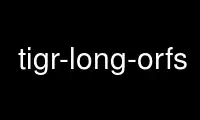
This is the command tigr-long-orfs that can be run in the OnWorks free hosting provider using one of our multiple free online workstations such as Ubuntu Online, Fedora Online, Windows online emulator or MAC OS online emulator
PROGRAM:
NAME
long-orfs — Find/Score potential genes in genome-file using the probability model in icm-
file
SYNOPSIS
tigr-long-orgs [genome-file options]
DESCRIPTION
Program long-orfs takes a sequence file (in FASTA format) and outputs a list of all long
"potential genes" in it that do not overlap by too much. By "potential gene" I mean the
portion of an orf from the first start codon to the stop codon at the end.
The first few lines of output specify the settings of various parameters in the program:
Minimum gene length is the length of the smallest fragment considered to be a gene. The
length is measured from the first base of the start codon to the last base *before* the
stop codon. This value can be specified when running the program with the -g option.
By default, the program now (April 2003) will compute an optimal length for this
parameter, where "optimal" is the value that produces the greatest number of long ORFs,
thereby increasing the amount of data used for training.
Minimum overlap length is a lower bound on the number of bases overlap between 2 genes
that is considered a problem. Overlaps shorter than this are ignored.
Minimum overlap percent is another lower bound on the number of bases overlap that is
considered a problem. Overlaps shorter than this percentage of *both* genes are ignored.
The next portion of the output is a list of potential genes:
Column 1 is an ID number for reference purposes. It is assigned sequentially starting
with 1 to all long potential genes. If overlapping genes are eliminated, gaps in the
numbers will occur. The ID prefix is specified in the constant ID_PREFIX .
Column 2 is the position of the first base of the first start codon in the orf. Currently
I use atg, and gtg as start codons. This is easily changed in the function Is_Start () .
Column 3 is the position of the last base *before* the stop codon. Stop codons are taa,
tag, and tga. Note that for orfs in the reverse reading frames have their start position
higher than the end position. The order in which orfs are listed is in increasing order
by Max {OrfStart, End}, i.e., the highest numbered position in the orf, except for orfs
that "wrap around" the end of the sequence.
When two genes with ID numbers overlap by at least a sufficient amount (as determined by
Min_Olap and Min_Olap_Percent ), they are eliminated and do not appear in the output.
The final output of the program (sent to the standard error file so it does not show up
when output is redirected to a file) is the length of the longest orf found.
Specifying Different Start and Stop Codons:
To specify different sets of start and stop codons, modify the file gene.h .
Specifically, the functions:
Is_Forward_Start Is_Reverse_Start Is_Start Is_Forward_Stop Is_Reverse_Stop
Is_Stop
are used to determine what is used for start and stop codons.
Is_Start and Is_Stop do simple string comparisons to specify which patterns are used.
To add a new pattern, just add the comparison for it. To remove a pattern, comment out or
delete the comparison for it.
The other four functions use a bit comparison to determine start and stop patterns. They
represent a codon as a 12-bit pattern, with 4 bits for each base, one bit for each
possible value of the bases, T, G, C or A. Thus the bit pattern 0010 0101 1100
represents the base pattern [C] [A or G] [G or T]. By doing bit operations (& | ~) and
comparisons, more complicated patterns involving ambiguous reads can be tested
efficiently. Simple patterns can be tested as in the current code.
For example, to insert an additional start codon of CAT requires 3 changes: 1. The line ||
(Codon & 0x218) == Codon should be inserted into Is_Forward_Start , since 0x218 = 0010
0001 1000 represents CAT. 2. The line || (Codon & 0x184) == Codon should be inserted into
Is_Reverse_Start , since 0x184 = 0001 1000 0100 represents ATG, which is the reverse-
complement of CAT. Alternately, the #define constant ATG_MASK could be used. 3. The
line || strncmp (S, "cat", 3) == 0 should be inserted into Is_Start .
OPTIONS
-g n Set minimum gene length to n. Default is to compute an optimal value
automatically. Don't change this unless you know what you're doing.
-l Regard the genome as linear (not circular), i.e., do not allow genes to "wrap
around" the end of the genome. This option works on both glimmer and long-orfs
. The default behavior is to regard the genome as circular.
-o n Set maximum overlap length to n. Overlaps shorter than this are permitted.
(Default is 0 bp.)
-p n Set maximum overlap percentage to n%. Overlaps shorter than this percentage of
*both* strings are ignored. (Default is 10%.)
Use tigr-long-orfs online using onworks.net services
